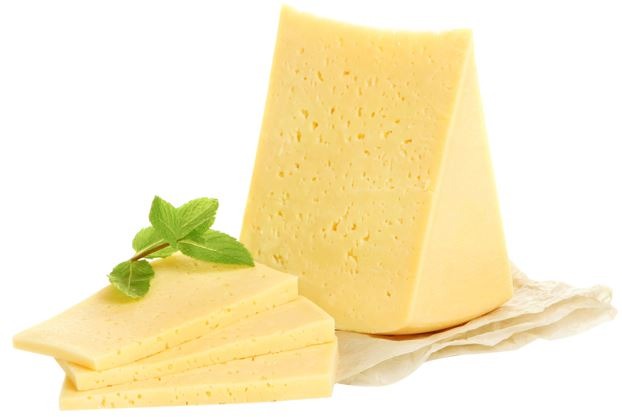Anybody that has hosted a cheese tasting party or put out a selection for guests to savor with other snacks understands that you can’t please everybody. The Brie appears moldy, Cheddar is overly sharp, and the blue is overly blue.
But there is one cheese that almost everyone enjoys—mild enough that kids will go crazy for it but interesting enough to appease any cheese connoisseur. It also adds some geographic diversity to your cheese platter, as it is likely to be the only representation of Denmark. This is the Havarti cheese.
What Kind of Cheese Is Havarti?
When you fantasize about cheese, you’re probably dreaming about Havarti. With its soft, creamy texture and buttery sweet flavor, whether infused with jalapeno or studded with dill, Havarti entices you to sample, savor, and swoon.
Hanne Nielsen, the Danish woman who journeyed around Europe learning cheesemaking techniques, invented Havarti, a semi-soft cow’s-milk cheese, in the mid-1800s. She toyed with washing her cheese curds in fresh spring water before pressing and draining them when she returned to her farm in Denmark. This resulted in a soft, creamy, unique cheese named Havarthigaard, located north of Copenhagen in Øverød.
Nielsen sent cheese and butter to the Danish king and queen within a few years. The rest she planned to sell in her Copenhagen shop.
There are two kinds of Havarti: the original (produced from whole pasteurized cow’s milk) and flødehavarti or “cream Havarti,” which has cream added to increase the butterfat to what the French call a “double crème.”
Danish cheesemakers introduced the style to Wisconsin, where several award-winning creameries produce award-winning versions. Indeed, the top five Havarti entries in the 2015 United States Championship Cheese Contest were made by the Green County cheesemakers. The original Havarti is easier to find and far more popular in America than the cream version.
How Is Havarti Made?
Since its inception, Castello Havarti cheese’s recipe has remained unchanged, prioritizing taste and different uses.
Raw milk is pasteurized, and the cultures required for coagulation are added. When the curd has reached the desired consistency, it’s separated, drained of excess whey, and poured into molds.
The curds are then compressed and allowed to cool before brining. Depending on the preferred texture and flavor, the cheese may be aged for a few months to a year.
Traditionally made with little to nothing but pasteurized milk, Havarti is a pure cheese in terms of ingredients and flavor, and it is gluten-free in most versions. The cheese is generally suitable for vegetarians due to vegetarian rennet, but you should always check the labels.
How Does Havarti Cheese Taste?
Havarti is a smooth, rindless cheese that ranges in color from creamy to pale yellow and has irregular and very small “eyes.” It has a buttery aroma, and stronger varieties can be nuttier and sharper, similar to Swiss cheese. The flavor is slightly acidic and buttery, falling between Monterey Jack, Muenster cheese, and Butterkäse (“butter cheese”).
Because the smooth flavor of Havarti, like that of Monterey Jack, is a blank canvas for experimentation, it is frequently found flavored with dill and other herbs, hot peppers, horseradish, or caraway seeds.
How Should Havarti Cheese Be Cooked or Used in Recipes?
Pairing Havarti cheese with alcoholic beverages is a traditional way to use it in recipes. Because of its mild flavor, Havarti pairs well with wine and beer. However, you can pair it with any other liquor of your choice, and the outstanding flavor of the cheese will shine through.
Havarti cheese is also a flavorful addition to pizza, sandwiches, and burgers. It’s because Havarti is a wonderful melting cheese.
Another great way to incorporate Havarti into your diet is through cheese boards. It pairs well with fresh fruits like grapes, apples, and pears. You can also serve this cheese with a variety of crackers and nuts.
When Havarti cheese is used in desserts, its buttery aroma shines through. You can’t go wrong with a generous sprinkling or slice of Havarti cheese, from fondues to fruit casseroles.
Remember to properly store Havarti cheese because it is a semi-soft cheese with a shorter shelf life.
How Long Does Havarti Cheese Take to Age?
The length of time Havarti is aged depends on the desired flavor profile and the cheesemakers. Typically, the aging process lasts about three months. This ensures that the signature mild flavor and creaminess are maintained.
On the other hand, some varieties are aged for a year or more. This gives the cheese a firmer texture, slightly saltier flavor, and a specific nuttiness reminiscent of hazelnuts.
Wisconsin Havarti Cheeses You Must Try
Carr Valley Cheese Havarti
You can’t beat Carr Valley’s Havarti for a classic Havarti shining in its simplicity. This buttery, mild, and silky cheese is smoother than jazz. For a decadent duo, serve with fresh pears or raspberry jam.
Decatur Dairy Pepper Havarti
Do you want to spice things up? Try Decatur Dairy’s pepper-filled Havarti, which has just enough smokiness and heat to balance the cheese’s natural milkiness. This melt-in-your-mouth cheese is the ideal complement to any Southwestern dish.
Roth Cheese Dill Havarti
Roth Cheese’s Havarti is infused with earthy, bright dill for a subtle, savory twist on a classic. This delicate cheese pairs especially well with capers, smoked salmon, and radishes, making it a must-have for any weekend brunch.
Wine and Other Pairings
A wine and cheese party would be incomplete without Havarti. Serve it sliced with grapes, dried fruits, apples, and pears on a platter. Whole-wheat or whole-grain bread or crackers, water crackers, and butter crackers are ideal.
If you’re going to serve it with other cheeses, try mixed milk or goat cheese, an aged Cheddar, and some other contrasting flavors. It would be repetitive and bland to add Muenster or Butterkäse to the mix.
Havarti Substitutes
Havarti has many characteristics seen in other semi-hard cheeses that boast of being similarly versatile, thanks to the subtle and mild notes.
Cheddar, another popular cheese with a wide range of applications, is closely related to Havarti, even more so when aged. This cheese, which is stronger in aroma and flavor, is ideal for melting and has a slight tartness and sharp hazelnut notes.
Emmental has a firm texture ideal for slicing and soft hints of ripe fruit and mild butter flavors.




